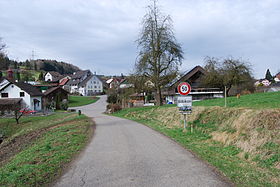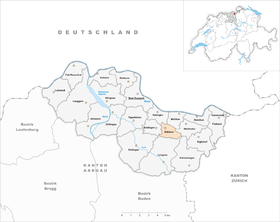Boebikon
| Boebikon | |
|---|---|
| State : |
|
| Canton : |
|
| District : | Zurzach |
| BFS no. : | 4302 |
| Postal code : | 5334 |
| Coordinates : | 667 363 / 267402 |
| Height : | 442 m above sea level M. |
| Height range : | 403-581 m above sea level M. |
| Area : | 2.60 km² |
| Residents: | 171 (December 31, 2019) |
| Population density : | 66 inhabitants per km² |
|
Proportion of foreigners : (residents without citizenship ) |
11.7% (December 31, 2019) |
| Website: | www.boebikon.ch |
|
Boebikon |
|
| Location of the municipality | |
Böbikon ( Swiss German : ˈbœbikχə ) is a municipality in the Swiss canton of Aargau . It belongs to the Zurzach district and is just under two kilometers south of the border with Germany .
geography
The community lies in the middle of the Table Jura in a narrow and elongated valley basin that is closed on all sides. This is traversed in an east-west direction by the Chrüzlibach, which flows into the Upper Rhine near Rekingen . Immediately to the west of the village begins a ravine that reaches a depth of 50 meters in the municipality and is up to 120 meters deep in the further course. The northern municipal boundary runs along the ridge of the steep Güggehübucks ( 556 m above sea level ). South of the brook, the terrain rises to the Haslihaus plateau ( 580 m above sea level ). In addition to the main settlement of Böbikon, there is also the small hamlet of Rütihof ( 539 m above sea level ) one kilometer southwest on the edge of the plateau. There are also several individual farms.
The area of the municipality is 260 hectares , of which 100 hectares are forested and 20 hectares are built over. The highest point is at 580 meters on the Haslihau plateau, the lowest at 400 meters in the Chrüzlibach Gorge. Neighboring communities are Rekingen in the northwest, Mellikon in the north, Wislikofen in the east, Lengnau in the south and Baldingen in the west.
history

Bebikon was first mentioned in a document in 1113. At that time, the nobles von Waldhausen donated the Wislikofen priory and for this purpose donated extensive property in the region to the St. Blasien monastery . The place name comes from the Old High German Babinghofun and means "at the courtyards of Babo". In 1241 the monastery acquired an additional farm in Böbikon. Another major landowners was the Canons in Zurzacher Verena Minster . From around 1100 to 1250 the small Böbikon Castle, inhabited by ministerials, existed on the western edge of the village .
The Swiss conquered Aargau in 1415 and Böbikon now belonged to the Ehrendingen office in the county of Baden , a common rule . In the 14th and 15th centuries, the lower jurisdiction lay with the Lords of Liebegg , from 1506 to 1671 with the Sion monastery in Klingnau , and then with private individuals. In March 1798 the French took Switzerland and proclaimed the Helvetic Republic . Böbikon was initially a municipality in the short-lived canton of Baden , since 1803 it has belonged to the canton of Aargau. Böbikon was part of the Zurzach parish until 1883 and has since formed its own parish together with Baldingen .
In 1844 the journalist Franz Xaver Bronner wrote the following about the community: «Böbikon, community in the Wislikofen parish, Kaiserstuhl district, Zurzach district. It includes the local citizenship of Rütihof, which is about half an hour away towards the Surbthal. Both have a total of 125 male, 117 female, together 242 inhabitants in 6 brick, 18 thatched houses, 12 brick and 3 thatched outbuildings. The hamlet of Hasle also belongs to this municipality. "
In the first half of the 19th century, the population increased by more than two and a half times to a high that has never been reached since. This rapid increase resulted in the impoverishment of large groups, which is why many residents moved away (not a few emigrated overseas). By 1900 the population fell by more than a third, stagnated for several decades and then fell to the lowest level of 119 by 1980. However, an increase has been recorded since then. Böbikon has remained an agricultural community to this day.
In 2000 Böbikon joined the administrative cooperation "Verwaltung2000", which handles the administrative tasks of seven communities in the neighborhood. The municipality has been involved in the “Rheintal +” project since 2014, which envisages the merger of nine municipalities to form the municipality of Zurzach . After the community assembly approved the merger on May 23, 2019 with 52 to 12 votes, the decision was confirmed on September 8, 2019 in a referendum with 58 to 37 votes. This means that the merger will take place on January 1, 2022 (but without Mellikon , which narrowly refused).
Attractions
coat of arms
The blazon of the municipal coat of arms reads: "In blue, half a white mill wheel, elevated by a six-pointed white star." The municipality only introduced a coat of arms in 1939, but at that time the mill wheel was red instead of white and a ploughshare was attached to the star. In 1963 the current design was adopted. It is derived from the coat of arms of Caspar I. Müller ; the abbot of St. Blasien had the chapel renovated in 1565 and for this reason placed his family coat of arms over the door.
population
The population developed as follows:
| year | 1799 | 1850 | 1900 | 1930 | 1950 | 1960 | 1970 | 1980 | 1990 | 2000 | 2010 |
| Residents | 102 | 269 | 178 | 161 | 159 | 167 | 144 | 119 | 159 | 183 | 167 |
On December 31, 2019, 171 people lived in Böbikon, the proportion of foreigners was 11.7%. In the 2015 census, 49.7% described themselves as Roman Catholic and 16.4% as Reformed ; 33.9% were non-denominational or of other faiths. In the 2000 census, 98.9% stated German as their main language.
Politics and law
The assembly of those entitled to vote, the municipal assembly , exercises legislative power. The executing authority is the five-member municipal council . He is elected by the people in the majority procedure, his term of office is four years. The parish council leads and represents the parish. To this end, it implements the resolutions of the municipal assembly and the tasks assigned to it by the canton. The Zurzach District Court is the first instance responsible for legal disputes . Böbikon belongs to the XVII (Zurzach) judges' circle.
economy
According to the corporate structure statistics (STATENT) collected in 2015, Böbikon has around 70 jobs, of which 38% in agriculture, 32% in industry and 30% in the service sector. Most of the gainfully employed are commuters and work in Bad Zurzach and the surrounding area, some also in the Baden region .
traffic
Although the village is away from through traffic at the end of Kantonsstrasse 433, Hauptstrasse 7 between Basel and Winterthur is only a little over two kilometers away. A narrow side street leads to Lengnau in the Surbtal . A post bus line connects Bad Zurzach train station with Baldingen and Böbikon.
education
The community no longer has a school. The kindergarten and primary school can be attended in neighboring Rekingen , all upper levels ( Realschule , secondary school and district school ) in Bad Zurzach . The closest grammar schools are the Baden Cantonal School and the Wettingen Cantonal School .
Personalities
- Mirco Saggiorato (* 1988), racing cyclist
Web links
- Official website of the municipality of Böbikon
- Administration2000 (administrative cooperation)
- Andreas Steigmeier : Böbikon. In: Historical Lexicon of Switzerland .
Individual evidence
- ↑ Cantonal population statistics 2019. Department of Finance and Resources, Statistics Aargau, March 30, 2020, accessed on April 2, 2019 .
- ↑ Cantonal population statistics 2019. Department of Finance and Resources, Statistics Aargau, March 30, 2020, accessed on April 2, 2019 .
- ↑ a b Beat Zehnder: The community names of the canton of Aargau . In: Historical Society of the Canton of Aargau (Ed.): Argovia . tape 100 . Verlag Sauerländer, Aarau 1991, ISBN 3-7941-3122-3 , p. 95-96 .
- ^ National map of Switzerland, sheet 1050, Swisstopo.
- ↑ Standard area statistics - municipalities according to 4 main areas. Federal Statistical Office , November 26, 2018, accessed on June 17, 2019 .
- ^ Franz Xaver Bronner : The canton of Aargau, historically, geographically, statistically portrayed. St. Gallen, 1844, second volume, p. 290.
- ↑ About us. Verwaltung2000, accessed June 17, 2019 .
- ^ Philipp Zimmermann, Andreas Fretz, David Rutschmann: Grossfusion im Zurzibiet: 9 municipalities say yes to «Zurzach» - Fisibach refuses to join. Aargauer Zeitung , May 24, 2019, accessed on June 17, 2019 .
- ↑ Pirmin Kramer, Daniel Weissenbrunnen: Zurzibieter large merger is perfect! Eight municipalities say yes, only Mellikon refuses. Aargauer Zeitung , September 8, 2019, accessed on September 10, 2019 .
- ^ Joseph Galliker, Marcel Giger: Municipal coat of arms of the Canton of Aargau . Lehrmittelverlag des Kantons Aargau, book 2004, ISBN 3-906738-07-8 , p. 124 .
- ↑ Population development in the municipalities of the Canton of Aargau since 1850. (Excel) In: Eidg. Volkszählung 2000. Statistics Aargau, 2001, archived from the original on October 8, 2018 ; accessed on June 17, 2019 .
- ↑ Resident population by religious affiliation, 2015. (Excel) In: Population and Households, Community Tables 2015. Statistics Aargau, accessed on June 17, 2019 .
- ↑ Swiss Federal Census 2000: Economic resident population by main language as well as by districts and municipalities. (Excel) Statistics Aargau, archived from the original on August 12, 2018 ; accessed on June 17, 2019 .
- ↑ circles of justice of the peace. Canton of Aargau, accessed on June 17, 2019 .
- ↑ Statistics of the corporate structure (STATENT). (Excel, 157 kB) Statistics Aargau, 2016, accessed on June 17, 2019 .





